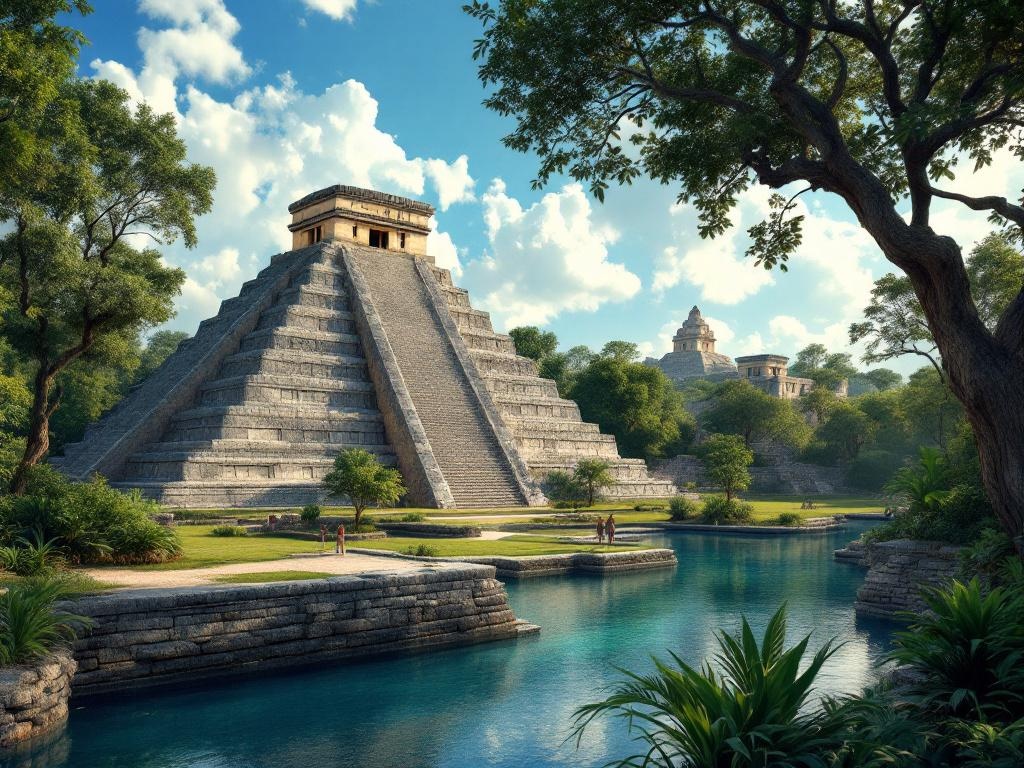Discovering Chichen Itza in Mexico
Journey back in time to Chichen Itza, the ancient Mayan metropolis in Mexico’s Yucatán Peninsula. Explore El Castillo, the iconic pyramid, and uncover the secrets of Mayan astronomy. Discover the Great Ball Court and the Sacred Cenote, vital centers of ritual and culture. From the Temple of the Warriors to El Caracol observatory, Chichen Itza offers a captivating blend of history, architecture, and cultural significance. Plan your visit today and experience one of the New 7 Wonders of the World!
Important information

- Chichen Itza, a Mayan city in Mexico’s Yucatán Peninsula, flourished from 600-1200 AD and is a UNESCO World Heritage Site.
- Key structures include El Castillo (Temple of Kukulcán), the Great Ball Court, the Temple of the Warriors, and El Caracol observatory.
- The site blends Mayan and Toltec cultures, seen in architecture and religious practices.
- Chichen Itza is open daily from 8 am to 5 pm, with an entrance fee of 648 Mexican pesos.
- It’s accessible from Cancun, Playa del Carmen, and Tulum by car or bus, and various guided tours are available.
Discovering Chichen Itza: An Introduction to the Ancient Maya City
Chichen Itza, an ancient Maya city in Yucatán, Mexico, flourished between 600 and 1200 AD. This major hub in the Northern Maya Lowlands showcases diverse architectural styles, reflecting its significant role in Maya civilization. At its heart stands El Castillo, a pyramid-shaped temple. Other ruins offer valuable insights into Maya culture, history, and architectural prowess. Visiting Chichen Itza is truly a journey through time. Before you travel, make sure you have the necessary visa or permits. Check the latest entry requirements here.
The Historical Significance of Chichen Itza
Chichen Itza, a prominent Maya city, flourished in the Northern Maya Lowlands from 600 to 900 AD during the Late Classic period. It extended its influence through the Terminal Classic (800-900 AD) and into the early Postclassic period (900-1200 AD). American explorer John Lloyd Stephens rediscovered this lost metropolis in 1841. Recognizing its global significance, UNESCO designated Chichen Itza a World Heritage site in 1988.
The Role of Chichen Itza in the Northern Maya Lowlands
Chichen Itza, a prominent Maya city in the Northern Lowlands, held significant sway over the region. This powerful center shaped political, economic, and religious life, impacting trade routes, cultural practices, and even architectural styles. From its central location in the Maya world, Chichen Itza disseminated knowledge and traditions far and wide.
The Rediscovery and Designation as a UNESCO World Heritage Site
Rediscovered in 1841, Chichen Itza’s importance wasn’t formally recognized until 1988 when UNESCO designated it a World Heritage Site. This designation acknowledges the site’s cultural and historical significance, emphasizing the need for its preservation. Chichen Itza showcases the Maya civilization’s grandeur, particularly through its impressive architecture. The well-preserved ruins also reflect a blend of cultures, offering valuable insights into Mayan society, religion, and scientific advancements.
Architectural Marvels of Chichen Itza
Chichen Itza, an ancient Mayan city on Mexico’s Yucatán Peninsula, boasts stunning architecture. El Castillo, also known as the Temple of Kukulcán, is a step pyramid that reflects the Mayans’ advanced understanding of astronomy. The Great Ball Court, another important structure, served as the venue for ritualistic games. The Temple of the Warriors showcases intricate carvings, a testament to Mayan artistry. El Caracol, the observatory, is another remarkable structure used by the Mayans for astronomical observation.
Temple of Kukulcán: The Iconic Pyramid El Castillo
El Castillo, also known as the Temple of Kukulcán, is a step pyramid that showcases the Maya’s astronomical knowledge. This iconic Chichen Itza structure highlights the civilization’s impressive architectural and engineering skills.
The Sacred Cenote: A Historical and Ritual Site
The Sacred Cenote at Chichen Itza, a natural sinkhole, played a vital role in Mayan rituals. Known as “Ts’onot-ki,” or “Cenote of the Itza well,” it even lent its name to the city itself. Archaeological discoveries have revealed evidence of offerings and sacrifices, highlighting the cenote’s significance in Mayan culture.
The Great Ball Court and the Mesoamerican Ballgame
Dominating Chichen Itza is Mesoamerica’s largest ball court, an immense playing field stretching 545 feet long and 225 feet wide. More than mere sport, this game held profound religious significance for the Maya.
Players, using only their bodies (excluding hands), propelled a rubber ball toward a high stone ring affixed to the court walls. Intricate carvings adorn the walls, depicting scenes from the game and highlighting its ritual importance, offering a glimpse into the Maya’s rich culture. This impressive structure stands as a testament to their ingenuity and spiritual devotion.
The Temple of the Warriors and the Thousand Columns
The towering Temple of the Warriors at Chichen Itza showcases carvings of Mayan life on its columns. These carvings depict both military and religious scenes, offering a glimpse into this fascinating ancient civilization and its complex culture.
El Caracol: The Ancient Observatory
Known as “El Caracol,” meaning “the snail” in Spanish, this ancient Mayan observatory is shaped like a spiral staircase enclosed within a circular tower. Its unique design and placement enabled Mayan astronomers to track celestial events, demonstrating their advanced knowledge of the universe. El Caracol remains an impressive example of Mayan innovation.
The Maya Civilization and Cultural Influence
Chichen Itza, a prominent Maya metropolis, thrived as a center of commerce and political influence, profoundly shaping the region’s cultural landscape. Its impressive architecture, including the Great Ball Court, reflects a sophisticated society. Structures like the Temple of the Warriors further demonstrate advanced Mayan knowledge of astronomy, mathematics, and art. Religious ceremonies played a vital role in city life, exemplified by sacred sites such as the Sacred Cenote. Chichen Itza represents a captivating fusion of Maya and Toltec traditions, a blend that continues to intrigue us today.
The Political Organization and Economic Power of Chichen Itza
Chichen Itza was a major economic power, controlling valuable resources like salt and obsidian. This economic clout translated into significant political influence over nearby Maya communities.
Rulers likely forged alliances and implemented tribute systems to maintain control. Archaeological evidence suggests a stratified society where elites held considerable power.
Ritual Practices and the Significance of Sacred Sites
Chichen Itza held deep spiritual significance for the Maya civilization. They conducted various rituals at its sacred sites, with the Sacred Cenote, a natural sinkhole, playing a central role. The Maya believed this cenote was a portal to the gods, where they offered precious artifacts and, tragically, even human sacrifices. However, their rituals weren’t solely focused on sacrifice; they also celebrated life and the cyclical nature of the world around them. These ceremonies, often led by rulers showcasing their authority and perceived divine connection, served to reinforce the Mayan social hierarchy.
The Influence of Toltec and Maya Cultures
Chichen Itza showcases a captivating blend of Maya and Toltec cultures. The iconic pyramid, El Castillo, embodies this fusion, integrating Maya astronomical knowledge with distinctive Toltec architectural features. Warrior motifs are prominent throughout the site, accompanied by numerous depictions of feathered serpents, a key symbol of Toltec influence. Religious practices at Chichen Itza further demonstrate this cultural synthesis, merging Maya and Toltec beliefs.
The Modern Recognition of Chichen Itza
Chichen Itza, one of the New 7 Wonders of the World, earned this distinction in 2007 through a global poll conducted by the New7Wonders Foundation. This major Central American tourist attraction draws millions of visitors annually. Its recognition as a UNESCO World Heritage Site in 1988 underscores its remarkable historical and cultural significance.
Chichen Itza as a New 7 Wonders of the World
Chichen Itza, one of the New 7 Wonders of the World, stands as a testament to its rich Mayan and Toltec heritage. This remarkable site, also designated a UNESCO World Heritage Site, holds immense historical and cultural significance.
Chichen Itza’s Role as a Major Tourist Attraction in Central America
Chichen Itza, a popular tourist destination in Central America, attracts over 2.6 million visitors annually. Its accessibility from surrounding areas contributes significantly to its popularity.
Visiting Chichen Itza: Practical Information
Getting to Chichen Itza from Cancun takes about 2.5 hours by car. The drive from Playa del Carmen is closer to two hours, while from Tulum, it’s about 1.5 to two hours. Transportation options include booking through tour operators or taking a public bus.Chichen Itza is open daily from 8:00 am to 5:00 pm. There is an entrance fee, and a separate fee for video cameras.
Tour options
- Classic overview tours.
- Deluxe packages with extras like meals.
- Private tours for a personalized experience.
- Luxury tours with premium services and amenities.
Tips for your visit
- Wear comfortable shoes for extensive walking.
- Bring essentials: sunscreen, a hat, sunglasses, and plenty of water.
- Arrive early to avoid crowds.
- Consider a guided tour for historical insights.
- Please respect the site’s cultural significance; climbing on the structures is prohibited.
How to Get to Chichen Itza from Cancun, Playa del Carmen, and Tulum
Chichen Itza is easily accessible from these popular tourist destinations:
Cancun
A two-hour drive (120 km) by car or organized tour bus.
Playa del Carmen
A 2.5 to 3-hour drive (180-200 km) by car or bus.
Tulum
A 2 to 2.5-hour drive (160-180 km) by car or tour.
Tours and Transportation
Guided tours and public buses are readily available from all three locations.
Chichen Itza Entrance Fee and Opening Hours
The entrance fee to Chichen Itza is 648 Mexican pesos per person. The site is open daily from 8 am to 5 pm, with last entry at 4 pm. Plan your visit accordingly.
Tour Options: Classic, Deluxe, Private, and Luxury Tours
Classic tours are a great starting point, offering transport and a guided tour of the main attraction.
For a more intimate experience, choose a deluxe tour with smaller groups and expert guides, granting access to exclusive areas.
Private tours offer personalized itineraries and dedicated guides, allowing you to customize your experience.
If you’re looking for premium service, luxury tours provide upscale transport, exclusive access, and unique cultural experiences for an unforgettable trip.
Travel Tips for a Memorable Tourist Experience
For a more relaxed visit, explore Chichen Itza during off-peak hours to avoid crowds.
Remember to bring water, especially if it’s hot.
Respect the site by not climbing the structures.
Guided tours provide valuable historical context and deeper insights. Booking in advance is crucial, particularly during peak season.
Learning about the Mayan civilization beforehand will enrich your experience and deepen your appreciation of this incredible site.




